Benefits/Disbenefits of Retinoids/Cisplatin in Breast Cancer Treatment
VerifiedAdded on 2022/09/29
|9
|1751
|26
Essay
AI Summary
This essay provides a critical review of cancer chemotherapy, specifically focusing on the use of retinoids and the platinum-containing drug cisplatin in the treatment of breast cancer. It begins with an introduction to breast cancer, its etiology, and pathogenesis, including the role of genetic mutations and DNA damage, leading to tumor formation and metastasis. The essay then discusses diagnostic methods like imaging tests and biopsies, followed by a detailed examination of medical management strategies, particularly chemotherapy. Cisplatin, its advantages, and disadvantages, including its effects on blood cells, menopausal symptoms, blood clots, allergic reactions, and peripheral neuropathy, are thoroughly analyzed. The essay also explores retinoids, their classification, advantages such as regulating cell differentiation, proliferation, apoptosis, and immune function, along with their limitations. The conclusion emphasizes the importance of cost-effective treatments and personalized approaches based on patient age and cancer stage. References to contemporary research are included to support the discussion. The essay aims to provide a comprehensive understanding of the benefits and disbenefits of these chemotherapy agents in the context of breast cancer treatment.
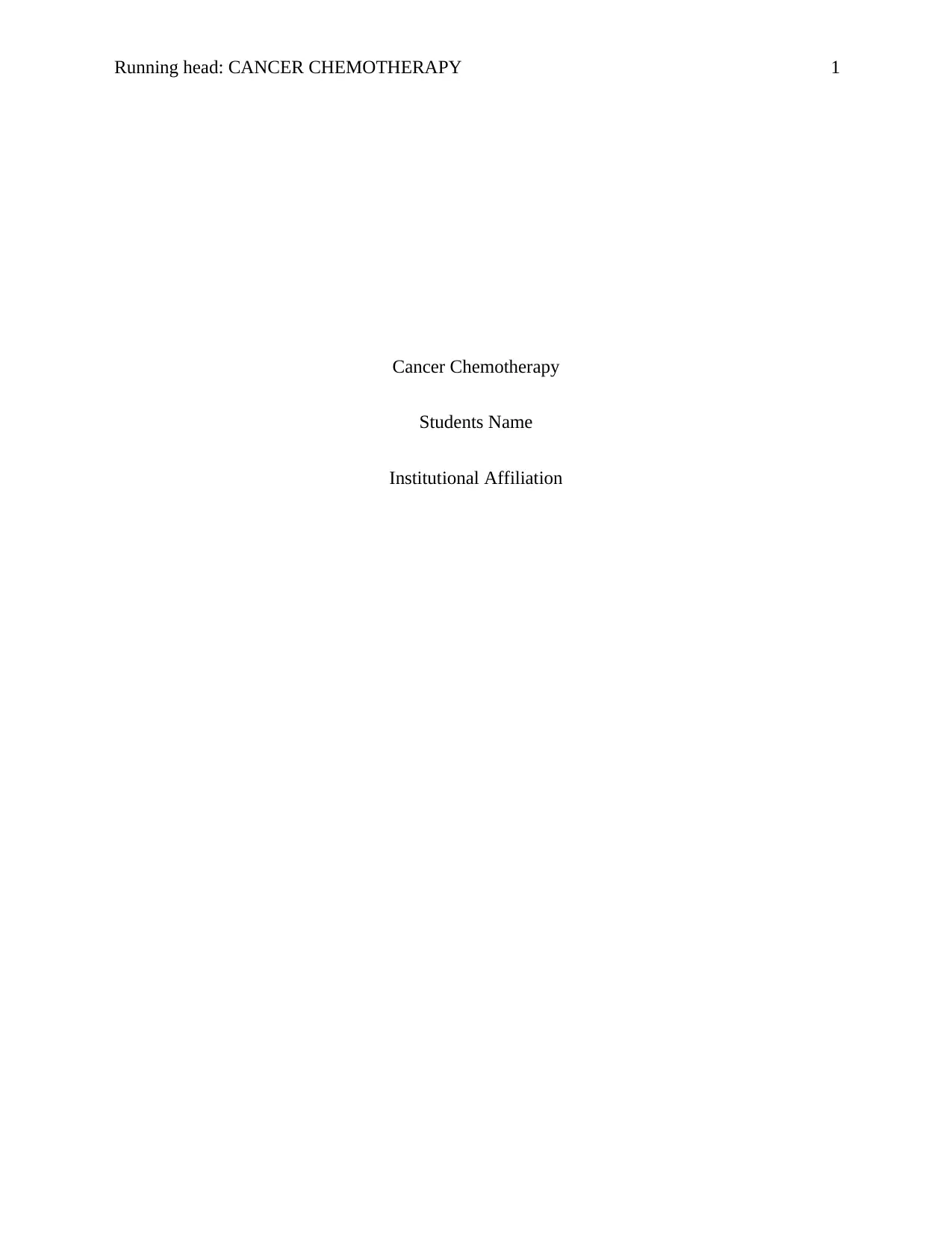
Running head: CANCER CHEMOTHERAPY 1
Cancer Chemotherapy
Students Name
Institutional Affiliation
Cancer Chemotherapy
Students Name
Institutional Affiliation
Paraphrase This Document
Need a fresh take? Get an instant paraphrase of this document with our AI Paraphraser
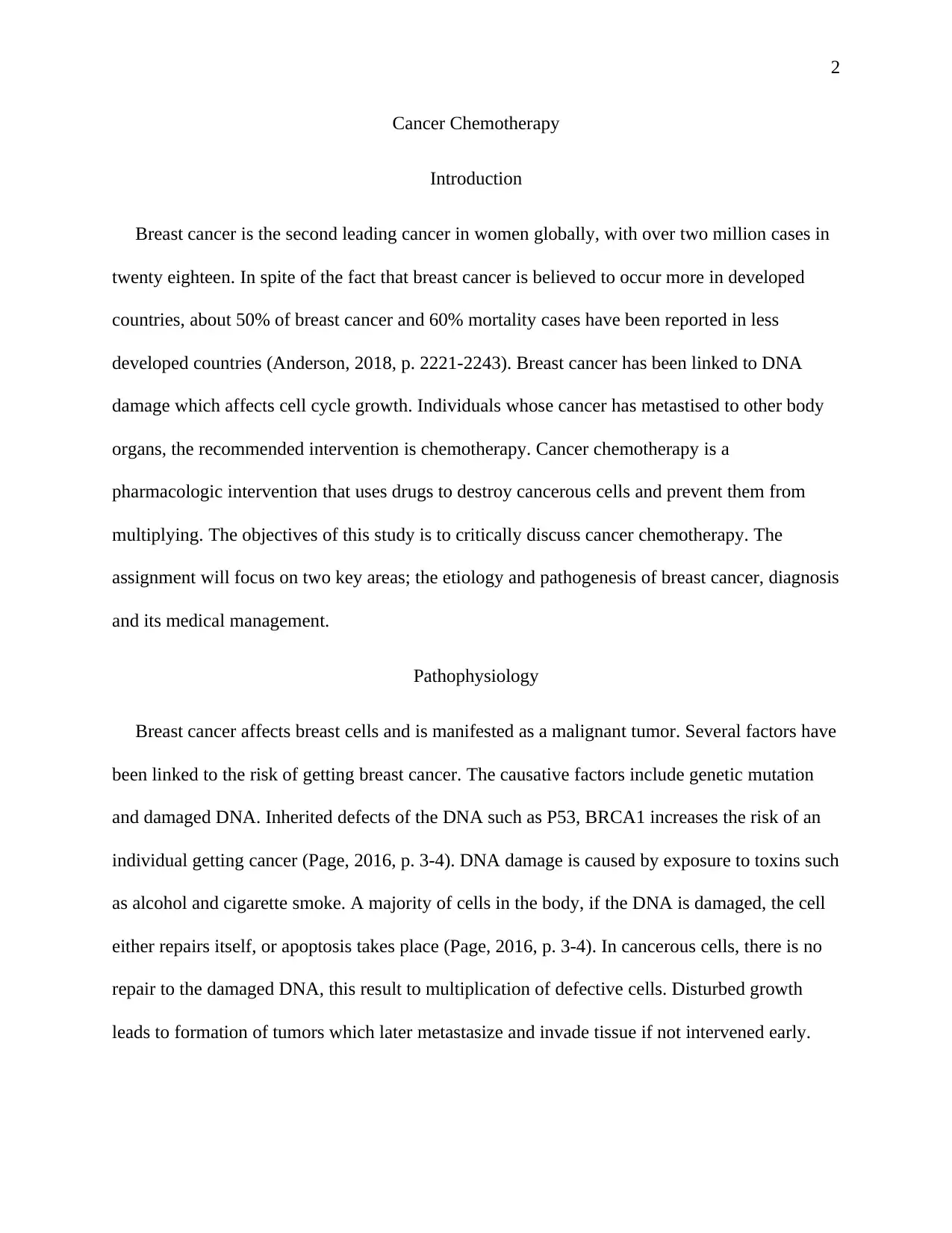
2
Cancer Chemotherapy
Introduction
Breast cancer is the second leading cancer in women globally, with over two million cases in
twenty eighteen. In spite of the fact that breast cancer is believed to occur more in developed
countries, about 50% of breast cancer and 60% mortality cases have been reported in less
developed countries (Anderson, 2018, p. 2221-2243). Breast cancer has been linked to DNA
damage which affects cell cycle growth. Individuals whose cancer has metastised to other body
organs, the recommended intervention is chemotherapy. Cancer chemotherapy is a
pharmacologic intervention that uses drugs to destroy cancerous cells and prevent them from
multiplying. The objectives of this study is to critically discuss cancer chemotherapy. The
assignment will focus on two key areas; the etiology and pathogenesis of breast cancer, diagnosis
and its medical management.
Pathophysiology
Breast cancer affects breast cells and is manifested as a malignant tumor. Several factors have
been linked to the risk of getting breast cancer. The causative factors include genetic mutation
and damaged DNA. Inherited defects of the DNA such as P53, BRCA1 increases the risk of an
individual getting cancer (Page, 2016, p. 3-4). DNA damage is caused by exposure to toxins such
as alcohol and cigarette smoke. A majority of cells in the body, if the DNA is damaged, the cell
either repairs itself, or apoptosis takes place (Page, 2016, p. 3-4). In cancerous cells, there is no
repair to the damaged DNA, this result to multiplication of defective cells. Disturbed growth
leads to formation of tumors which later metastasize and invade tissue if not intervened early.
Cancer Chemotherapy
Introduction
Breast cancer is the second leading cancer in women globally, with over two million cases in
twenty eighteen. In spite of the fact that breast cancer is believed to occur more in developed
countries, about 50% of breast cancer and 60% mortality cases have been reported in less
developed countries (Anderson, 2018, p. 2221-2243). Breast cancer has been linked to DNA
damage which affects cell cycle growth. Individuals whose cancer has metastised to other body
organs, the recommended intervention is chemotherapy. Cancer chemotherapy is a
pharmacologic intervention that uses drugs to destroy cancerous cells and prevent them from
multiplying. The objectives of this study is to critically discuss cancer chemotherapy. The
assignment will focus on two key areas; the etiology and pathogenesis of breast cancer, diagnosis
and its medical management.
Pathophysiology
Breast cancer affects breast cells and is manifested as a malignant tumor. Several factors have
been linked to the risk of getting breast cancer. The causative factors include genetic mutation
and damaged DNA. Inherited defects of the DNA such as P53, BRCA1 increases the risk of an
individual getting cancer (Page, 2016, p. 3-4). DNA damage is caused by exposure to toxins such
as alcohol and cigarette smoke. A majority of cells in the body, if the DNA is damaged, the cell
either repairs itself, or apoptosis takes place (Page, 2016, p. 3-4). In cancerous cells, there is no
repair to the damaged DNA, this result to multiplication of defective cells. Disturbed growth
leads to formation of tumors which later metastasize and invade tissue if not intervened early.
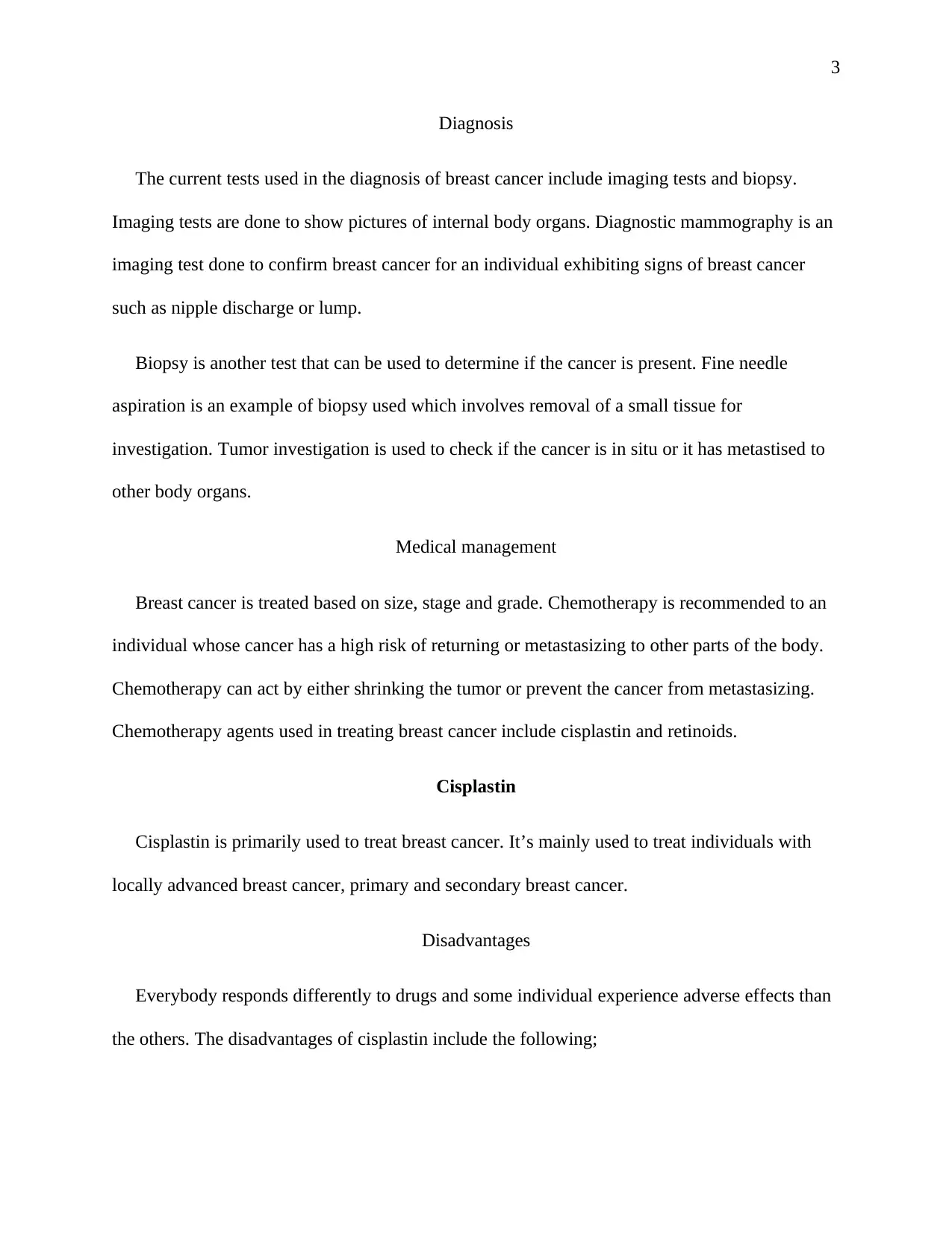
3
Diagnosis
The current tests used in the diagnosis of breast cancer include imaging tests and biopsy.
Imaging tests are done to show pictures of internal body organs. Diagnostic mammography is an
imaging test done to confirm breast cancer for an individual exhibiting signs of breast cancer
such as nipple discharge or lump.
Biopsy is another test that can be used to determine if the cancer is present. Fine needle
aspiration is an example of biopsy used which involves removal of a small tissue for
investigation. Tumor investigation is used to check if the cancer is in situ or it has metastised to
other body organs.
Medical management
Breast cancer is treated based on size, stage and grade. Chemotherapy is recommended to an
individual whose cancer has a high risk of returning or metastasizing to other parts of the body.
Chemotherapy can act by either shrinking the tumor or prevent the cancer from metastasizing.
Chemotherapy agents used in treating breast cancer include cisplastin and retinoids.
Cisplastin
Cisplastin is primarily used to treat breast cancer. It’s mainly used to treat individuals with
locally advanced breast cancer, primary and secondary breast cancer.
Disadvantages
Everybody responds differently to drugs and some individual experience adverse effects than
the others. The disadvantages of cisplastin include the following;
Diagnosis
The current tests used in the diagnosis of breast cancer include imaging tests and biopsy.
Imaging tests are done to show pictures of internal body organs. Diagnostic mammography is an
imaging test done to confirm breast cancer for an individual exhibiting signs of breast cancer
such as nipple discharge or lump.
Biopsy is another test that can be used to determine if the cancer is present. Fine needle
aspiration is an example of biopsy used which involves removal of a small tissue for
investigation. Tumor investigation is used to check if the cancer is in situ or it has metastised to
other body organs.
Medical management
Breast cancer is treated based on size, stage and grade. Chemotherapy is recommended to an
individual whose cancer has a high risk of returning or metastasizing to other parts of the body.
Chemotherapy can act by either shrinking the tumor or prevent the cancer from metastasizing.
Chemotherapy agents used in treating breast cancer include cisplastin and retinoids.
Cisplastin
Cisplastin is primarily used to treat breast cancer. It’s mainly used to treat individuals with
locally advanced breast cancer, primary and secondary breast cancer.
Disadvantages
Everybody responds differently to drugs and some individual experience adverse effects than
the others. The disadvantages of cisplastin include the following;
⊘ This is a preview!⊘
Do you want full access?
Subscribe today to unlock all pages.

Trusted by 1+ million students worldwide
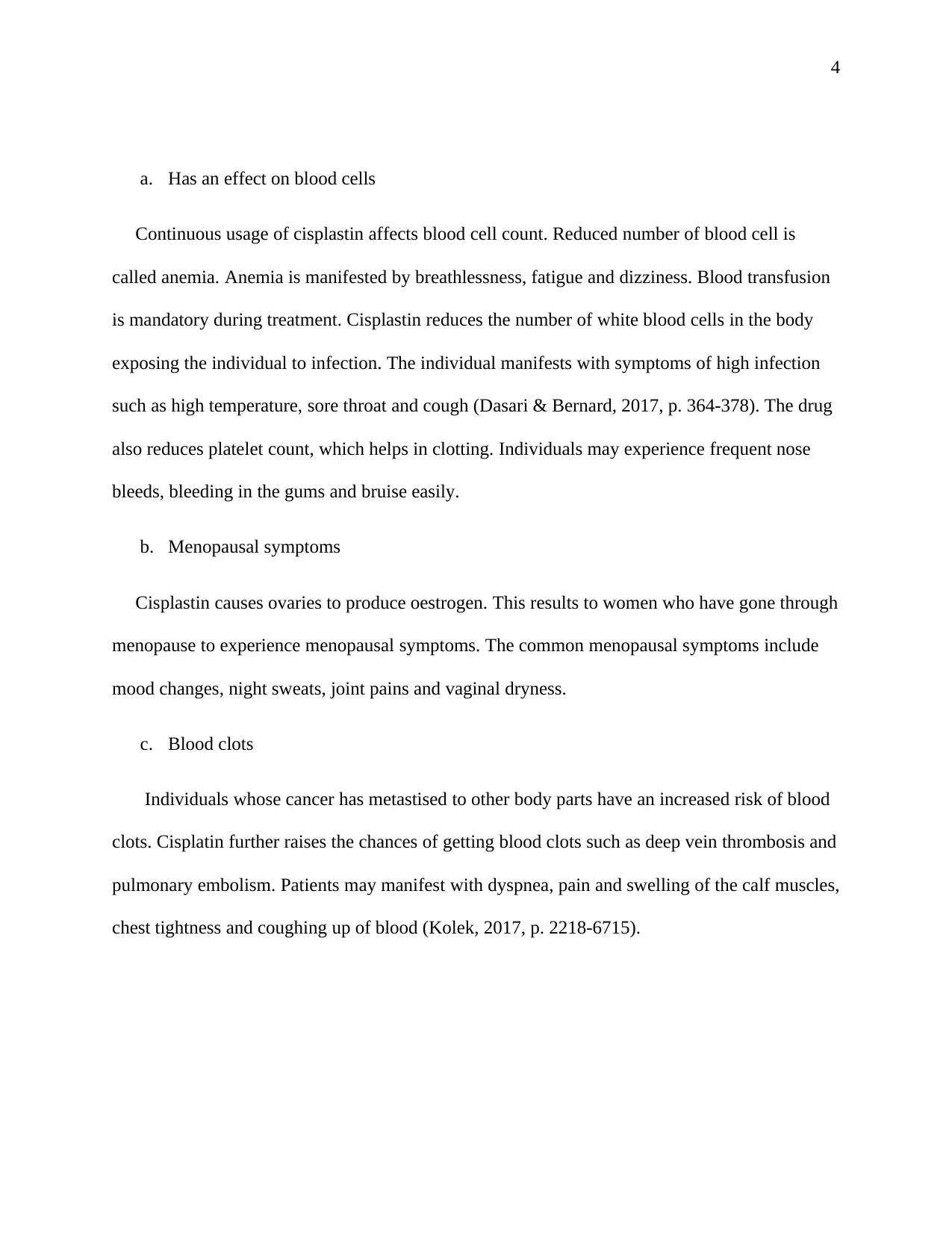
4
a. Has an effect on blood cells
Continuous usage of cisplastin affects blood cell count. Reduced number of blood cell is
called anemia. Anemia is manifested by breathlessness, fatigue and dizziness. Blood transfusion
is mandatory during treatment. Cisplastin reduces the number of white blood cells in the body
exposing the individual to infection. The individual manifests with symptoms of high infection
such as high temperature, sore throat and cough (Dasari & Bernard, 2017, p. 364-378). The drug
also reduces platelet count, which helps in clotting. Individuals may experience frequent nose
bleeds, bleeding in the gums and bruise easily.
b. Menopausal symptoms
Cisplastin causes ovaries to produce oestrogen. This results to women who have gone through
menopause to experience menopausal symptoms. The common menopausal symptoms include
mood changes, night sweats, joint pains and vaginal dryness.
c. Blood clots
Individuals whose cancer has metastised to other body parts have an increased risk of blood
clots. Cisplatin further raises the chances of getting blood clots such as deep vein thrombosis and
pulmonary embolism. Patients may manifest with dyspnea, pain and swelling of the calf muscles,
chest tightness and coughing up of blood (Kolek, 2017, p. 2218-6715).
a. Has an effect on blood cells
Continuous usage of cisplastin affects blood cell count. Reduced number of blood cell is
called anemia. Anemia is manifested by breathlessness, fatigue and dizziness. Blood transfusion
is mandatory during treatment. Cisplastin reduces the number of white blood cells in the body
exposing the individual to infection. The individual manifests with symptoms of high infection
such as high temperature, sore throat and cough (Dasari & Bernard, 2017, p. 364-378). The drug
also reduces platelet count, which helps in clotting. Individuals may experience frequent nose
bleeds, bleeding in the gums and bruise easily.
b. Menopausal symptoms
Cisplastin causes ovaries to produce oestrogen. This results to women who have gone through
menopause to experience menopausal symptoms. The common menopausal symptoms include
mood changes, night sweats, joint pains and vaginal dryness.
c. Blood clots
Individuals whose cancer has metastised to other body parts have an increased risk of blood
clots. Cisplatin further raises the chances of getting blood clots such as deep vein thrombosis and
pulmonary embolism. Patients may manifest with dyspnea, pain and swelling of the calf muscles,
chest tightness and coughing up of blood (Kolek, 2017, p. 2218-6715).
Paraphrase This Document
Need a fresh take? Get an instant paraphrase of this document with our AI Paraphraser
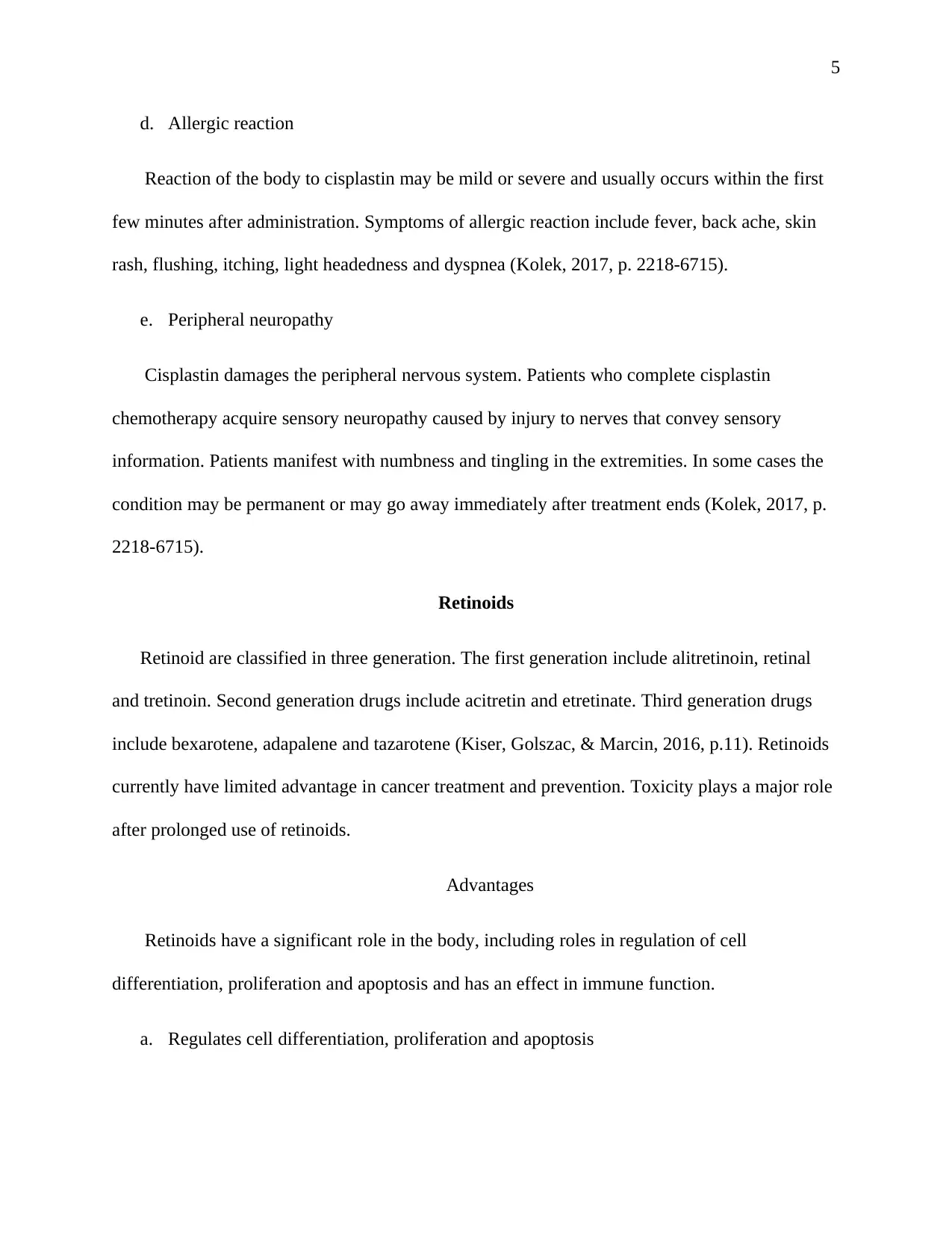
5
d. Allergic reaction
Reaction of the body to cisplastin may be mild or severe and usually occurs within the first
few minutes after administration. Symptoms of allergic reaction include fever, back ache, skin
rash, flushing, itching, light headedness and dyspnea (Kolek, 2017, p. 2218-6715).
e. Peripheral neuropathy
Cisplastin damages the peripheral nervous system. Patients who complete cisplastin
chemotherapy acquire sensory neuropathy caused by injury to nerves that convey sensory
information. Patients manifest with numbness and tingling in the extremities. In some cases the
condition may be permanent or may go away immediately after treatment ends (Kolek, 2017, p.
2218-6715).
Retinoids
Retinoid are classified in three generation. The first generation include alitretinoin, retinal
and tretinoin. Second generation drugs include acitretin and etretinate. Third generation drugs
include bexarotene, adapalene and tazarotene (Kiser, Golszac, & Marcin, 2016, p.11). Retinoids
currently have limited advantage in cancer treatment and prevention. Toxicity plays a major role
after prolonged use of retinoids.
Advantages
Retinoids have a significant role in the body, including roles in regulation of cell
differentiation, proliferation and apoptosis and has an effect in immune function.
a. Regulates cell differentiation, proliferation and apoptosis
d. Allergic reaction
Reaction of the body to cisplastin may be mild or severe and usually occurs within the first
few minutes after administration. Symptoms of allergic reaction include fever, back ache, skin
rash, flushing, itching, light headedness and dyspnea (Kolek, 2017, p. 2218-6715).
e. Peripheral neuropathy
Cisplastin damages the peripheral nervous system. Patients who complete cisplastin
chemotherapy acquire sensory neuropathy caused by injury to nerves that convey sensory
information. Patients manifest with numbness and tingling in the extremities. In some cases the
condition may be permanent or may go away immediately after treatment ends (Kolek, 2017, p.
2218-6715).
Retinoids
Retinoid are classified in three generation. The first generation include alitretinoin, retinal
and tretinoin. Second generation drugs include acitretin and etretinate. Third generation drugs
include bexarotene, adapalene and tazarotene (Kiser, Golszac, & Marcin, 2016, p.11). Retinoids
currently have limited advantage in cancer treatment and prevention. Toxicity plays a major role
after prolonged use of retinoids.
Advantages
Retinoids have a significant role in the body, including roles in regulation of cell
differentiation, proliferation and apoptosis and has an effect in immune function.
a. Regulates cell differentiation, proliferation and apoptosis
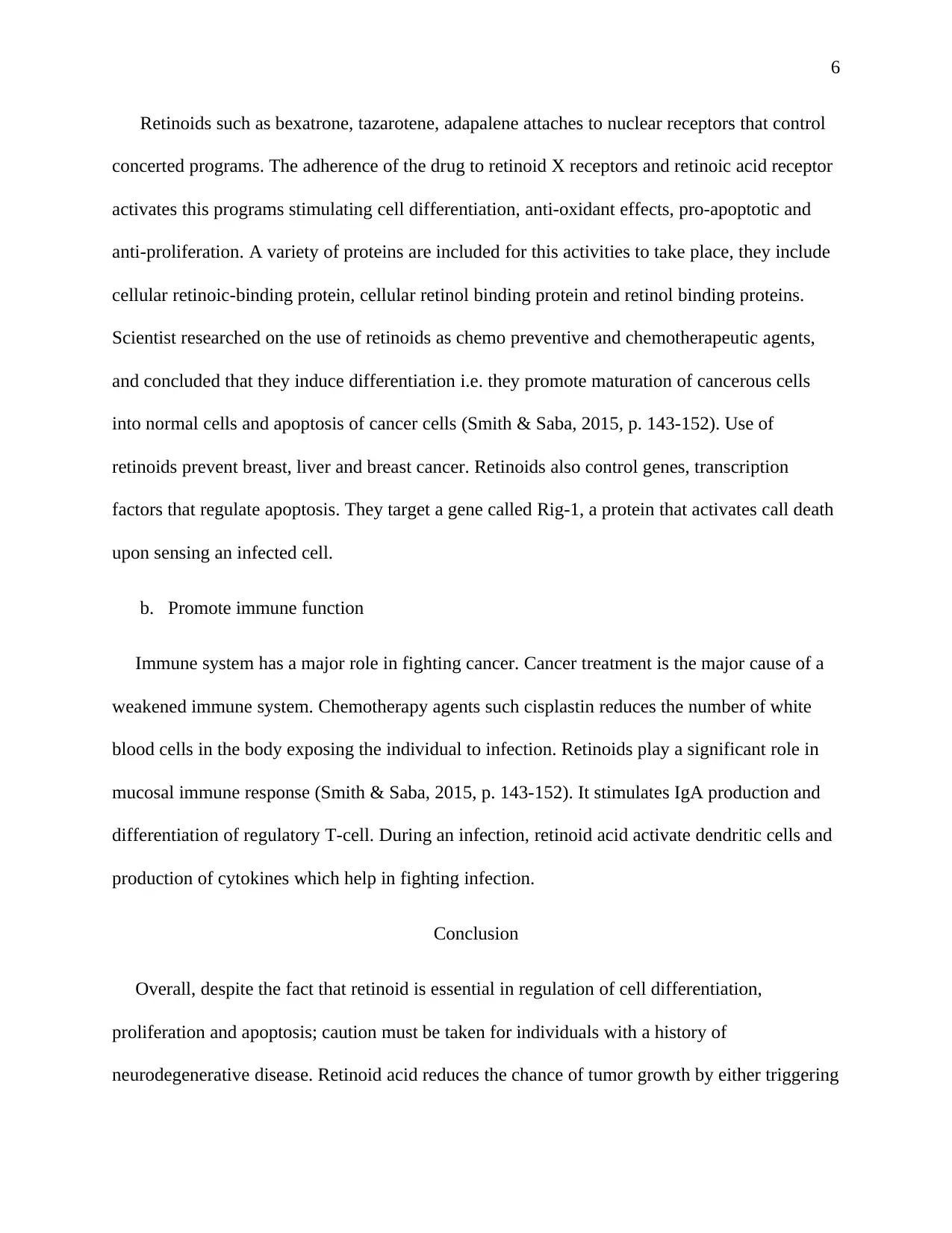
6
Retinoids such as bexatrone, tazarotene, adapalene attaches to nuclear receptors that control
concerted programs. The adherence of the drug to retinoid X receptors and retinoic acid receptor
activates this programs stimulating cell differentiation, anti-oxidant effects, pro-apoptotic and
anti-proliferation. A variety of proteins are included for this activities to take place, they include
cellular retinoic-binding protein, cellular retinol binding protein and retinol binding proteins.
Scientist researched on the use of retinoids as chemo preventive and chemotherapeutic agents,
and concluded that they induce differentiation i.e. they promote maturation of cancerous cells
into normal cells and apoptosis of cancer cells (Smith & Saba, 2015, p. 143-152). Use of
retinoids prevent breast, liver and breast cancer. Retinoids also control genes, transcription
factors that regulate apoptosis. They target a gene called Rig-1, a protein that activates call death
upon sensing an infected cell.
b. Promote immune function
Immune system has a major role in fighting cancer. Cancer treatment is the major cause of a
weakened immune system. Chemotherapy agents such cisplastin reduces the number of white
blood cells in the body exposing the individual to infection. Retinoids play a significant role in
mucosal immune response (Smith & Saba, 2015, p. 143-152). It stimulates IgA production and
differentiation of regulatory T-cell. During an infection, retinoid acid activate dendritic cells and
production of cytokines which help in fighting infection.
Conclusion
Overall, despite the fact that retinoid is essential in regulation of cell differentiation,
proliferation and apoptosis; caution must be taken for individuals with a history of
neurodegenerative disease. Retinoid acid reduces the chance of tumor growth by either triggering
Retinoids such as bexatrone, tazarotene, adapalene attaches to nuclear receptors that control
concerted programs. The adherence of the drug to retinoid X receptors and retinoic acid receptor
activates this programs stimulating cell differentiation, anti-oxidant effects, pro-apoptotic and
anti-proliferation. A variety of proteins are included for this activities to take place, they include
cellular retinoic-binding protein, cellular retinol binding protein and retinol binding proteins.
Scientist researched on the use of retinoids as chemo preventive and chemotherapeutic agents,
and concluded that they induce differentiation i.e. they promote maturation of cancerous cells
into normal cells and apoptosis of cancer cells (Smith & Saba, 2015, p. 143-152). Use of
retinoids prevent breast, liver and breast cancer. Retinoids also control genes, transcription
factors that regulate apoptosis. They target a gene called Rig-1, a protein that activates call death
upon sensing an infected cell.
b. Promote immune function
Immune system has a major role in fighting cancer. Cancer treatment is the major cause of a
weakened immune system. Chemotherapy agents such cisplastin reduces the number of white
blood cells in the body exposing the individual to infection. Retinoids play a significant role in
mucosal immune response (Smith & Saba, 2015, p. 143-152). It stimulates IgA production and
differentiation of regulatory T-cell. During an infection, retinoid acid activate dendritic cells and
production of cytokines which help in fighting infection.
Conclusion
Overall, despite the fact that retinoid is essential in regulation of cell differentiation,
proliferation and apoptosis; caution must be taken for individuals with a history of
neurodegenerative disease. Retinoid acid reduces the chance of tumor growth by either triggering
⊘ This is a preview!⊘
Do you want full access?
Subscribe today to unlock all pages.

Trusted by 1+ million students worldwide
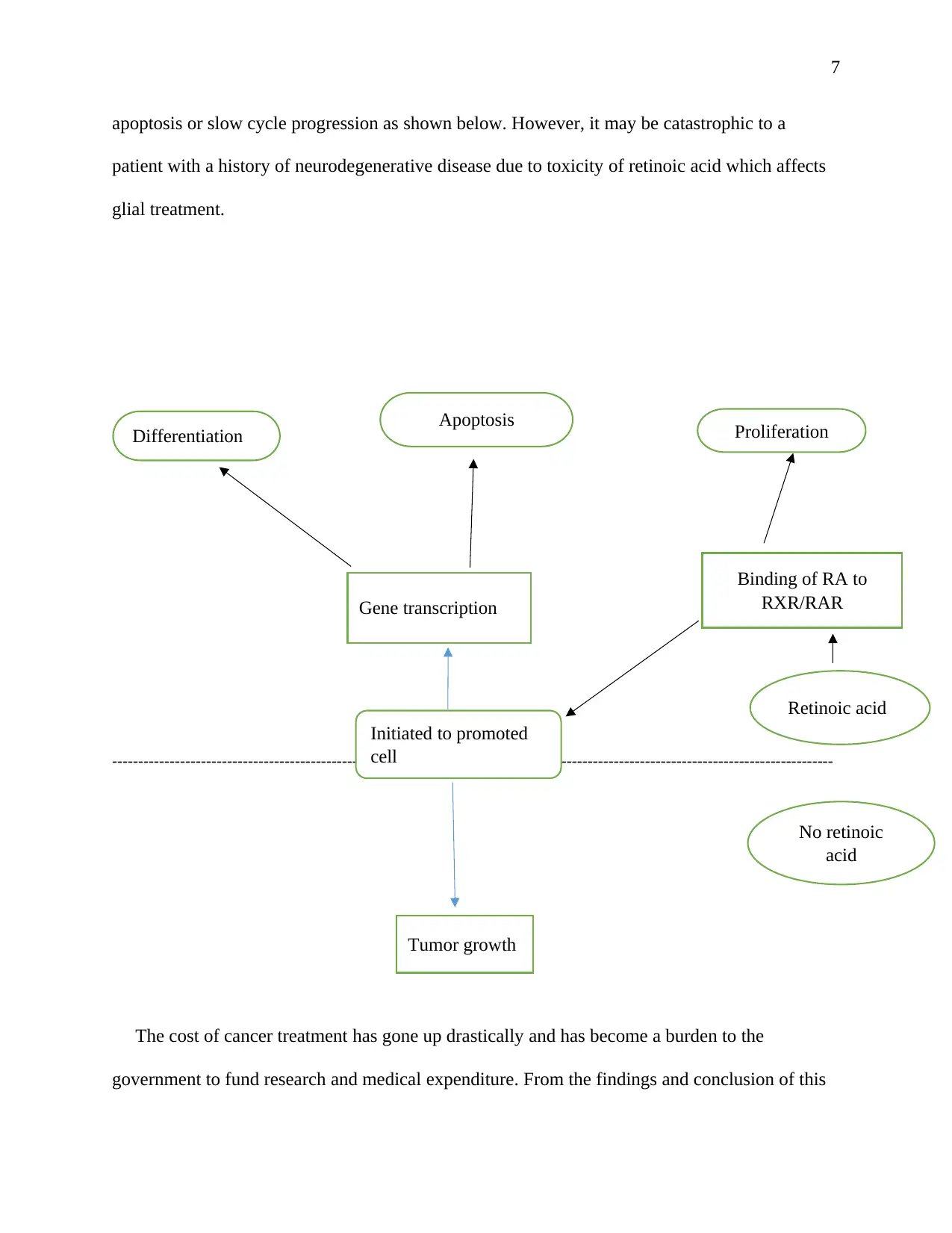
7
apoptosis or slow cycle progression as shown below. However, it may be catastrophic to a
patient with a history of neurodegenerative disease due to toxicity of retinoic acid which affects
glial treatment.
------------------------------------------------------------------------------------------------------------------------------------------
The cost of cancer treatment has gone up drastically and has become a burden to the
government to fund research and medical expenditure. From the findings and conclusion of this
Initiated to promoted
cell
Retinoic acid
No retinoic
acid
Binding of RA to
RXR/RARGene transcription
Differentiation Apoptosis Proliferation
Tumor growth
apoptosis or slow cycle progression as shown below. However, it may be catastrophic to a
patient with a history of neurodegenerative disease due to toxicity of retinoic acid which affects
glial treatment.
------------------------------------------------------------------------------------------------------------------------------------------
The cost of cancer treatment has gone up drastically and has become a burden to the
government to fund research and medical expenditure. From the findings and conclusion of this
Initiated to promoted
cell
Retinoic acid
No retinoic
acid
Binding of RA to
RXR/RARGene transcription
Differentiation Apoptosis Proliferation
Tumor growth
Paraphrase This Document
Need a fresh take? Get an instant paraphrase of this document with our AI Paraphraser
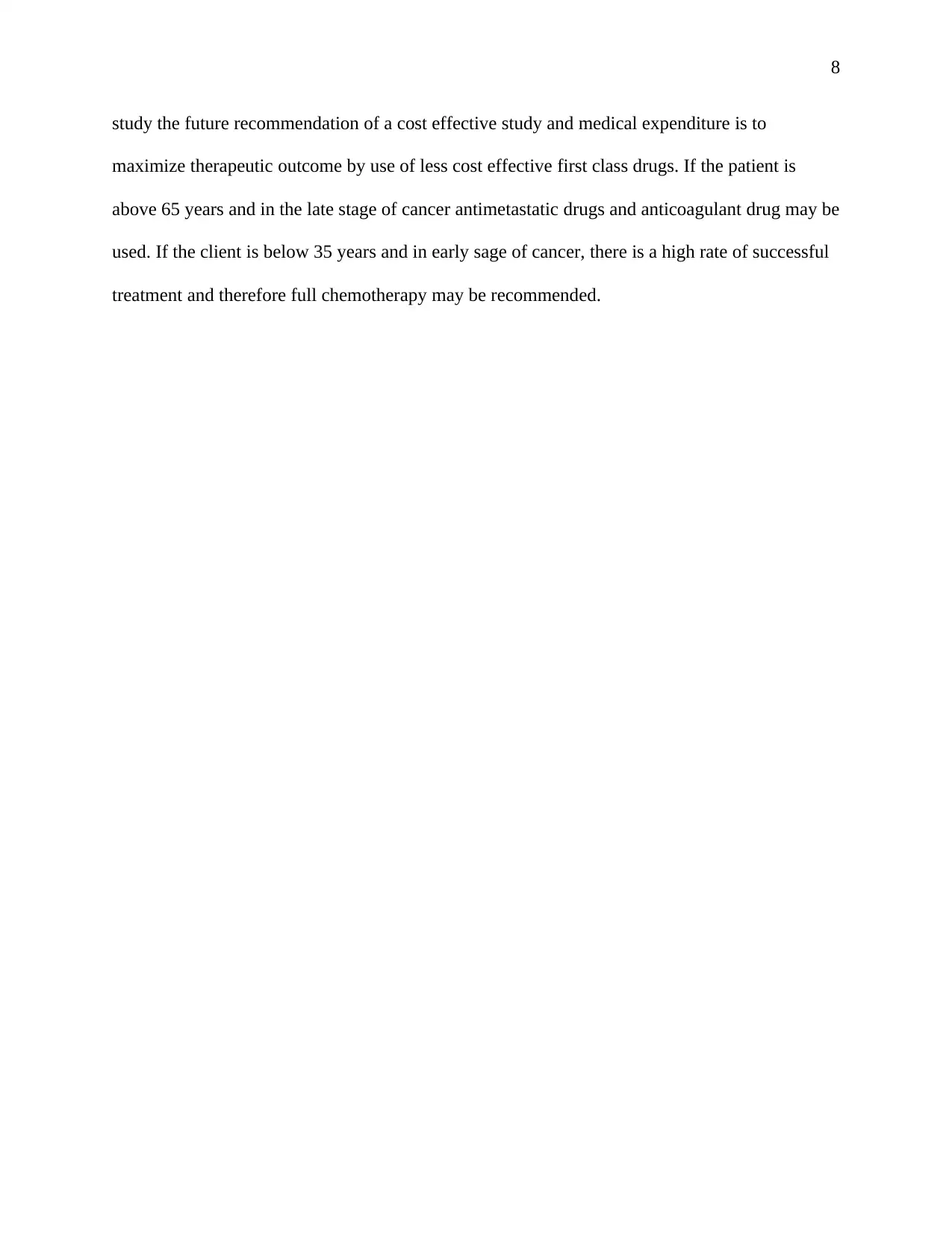
8
study the future recommendation of a cost effective study and medical expenditure is to
maximize therapeutic outcome by use of less cost effective first class drugs. If the patient is
above 65 years and in the late stage of cancer antimetastatic drugs and anticoagulant drug may be
used. If the client is below 35 years and in early sage of cancer, there is a high rate of successful
treatment and therefore full chemotherapy may be recommended.
study the future recommendation of a cost effective study and medical expenditure is to
maximize therapeutic outcome by use of less cost effective first class drugs. If the patient is
above 65 years and in the late stage of cancer antimetastatic drugs and anticoagulant drug may be
used. If the client is below 35 years and in early sage of cancer, there is a high rate of successful
treatment and therefore full chemotherapy may be recommended.
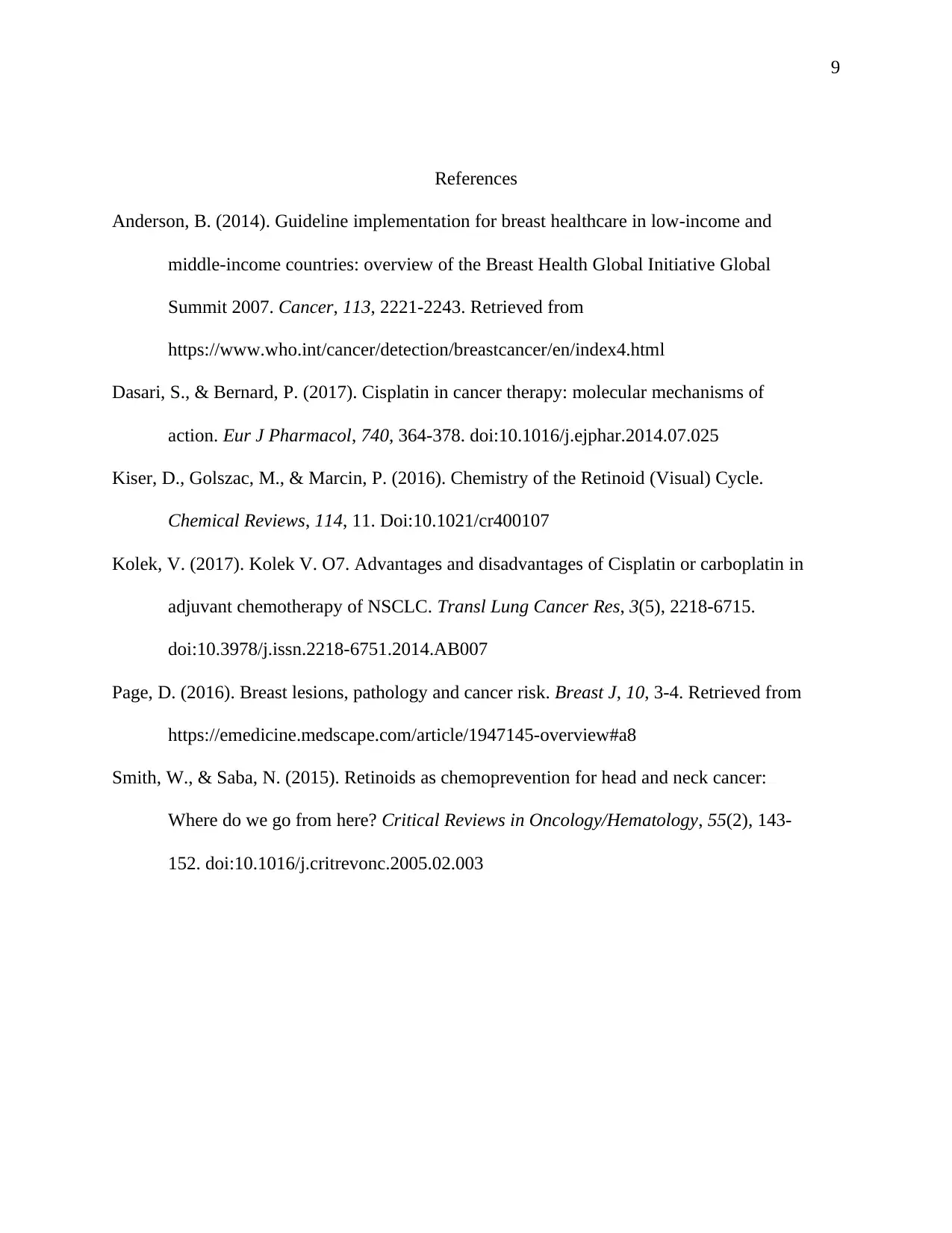
9
References
Anderson, B. (2014). Guideline implementation for breast healthcare in low-income and
middle-income countries: overview of the Breast Health Global Initiative Global
Summit 2007. Cancer, 113, 2221-2243. Retrieved from
https://www.who.int/cancer/detection/breastcancer/en/index4.html
Dasari, S., & Bernard, P. (2017). Cisplatin in cancer therapy: molecular mechanisms of
action. Eur J Pharmacol, 740, 364-378. doi:10.1016/j.ejphar.2014.07.025
Kiser, D., Golszac, M., & Marcin, P. (2016). Chemistry of the Retinoid (Visual) Cycle.
Chemical Reviews, 114, 11. Doi:10.1021/cr400107
Kolek, V. (2017). Kolek V. O7. Advantages and disadvantages of Cisplatin or carboplatin in
adjuvant chemotherapy of NSCLC. Transl Lung Cancer Res, 3(5), 2218-6715.
doi:10.3978/j.issn.2218-6751.2014.AB007
Page, D. (2016). Breast lesions, pathology and cancer risk. Breast J, 10, 3-4. Retrieved from
https://emedicine.medscape.com/article/1947145-overview#a8
Smith, W., & Saba, N. (2015). Retinoids as chemoprevention for head and neck cancer:
Where do we go from here? Critical Reviews in Oncology/Hematology, 55(2), 143-
152. doi:10.1016/j.critrevonc.2005.02.003
References
Anderson, B. (2014). Guideline implementation for breast healthcare in low-income and
middle-income countries: overview of the Breast Health Global Initiative Global
Summit 2007. Cancer, 113, 2221-2243. Retrieved from
https://www.who.int/cancer/detection/breastcancer/en/index4.html
Dasari, S., & Bernard, P. (2017). Cisplatin in cancer therapy: molecular mechanisms of
action. Eur J Pharmacol, 740, 364-378. doi:10.1016/j.ejphar.2014.07.025
Kiser, D., Golszac, M., & Marcin, P. (2016). Chemistry of the Retinoid (Visual) Cycle.
Chemical Reviews, 114, 11. Doi:10.1021/cr400107
Kolek, V. (2017). Kolek V. O7. Advantages and disadvantages of Cisplatin or carboplatin in
adjuvant chemotherapy of NSCLC. Transl Lung Cancer Res, 3(5), 2218-6715.
doi:10.3978/j.issn.2218-6751.2014.AB007
Page, D. (2016). Breast lesions, pathology and cancer risk. Breast J, 10, 3-4. Retrieved from
https://emedicine.medscape.com/article/1947145-overview#a8
Smith, W., & Saba, N. (2015). Retinoids as chemoprevention for head and neck cancer:
Where do we go from here? Critical Reviews in Oncology/Hematology, 55(2), 143-
152. doi:10.1016/j.critrevonc.2005.02.003
⊘ This is a preview!⊘
Do you want full access?
Subscribe today to unlock all pages.

Trusted by 1+ million students worldwide
1 out of 9
Related Documents
Your All-in-One AI-Powered Toolkit for Academic Success.
+13062052269
info@desklib.com
Available 24*7 on WhatsApp / Email
![[object Object]](/_next/static/media/star-bottom.7253800d.svg)
Unlock your academic potential
Copyright © 2020–2025 A2Z Services. All Rights Reserved. Developed and managed by ZUCOL.





